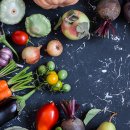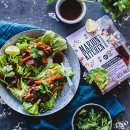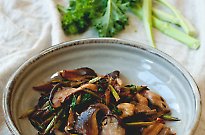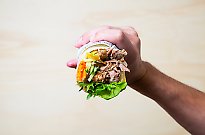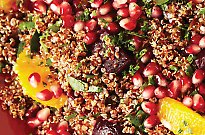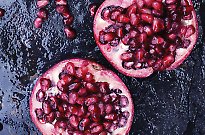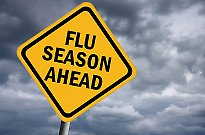
Superfood spotlight: cooking with chickpeas
Superfood spotlight: cooking with chickpeas

The chickpea, also known as the garbanzo bean, is a legume of the family Fabaceae. This family of flowering plants is one of the largest plant families, also including peas, peanuts and lupines, amongst others. The chickpea is one of the most widely grown and eaten bean in the world, second only to the soybean.
Chickpeas have a delicious nutlike taste and a buttery texture. A very versatile legume, they are the base ingredient in traditional hummus and falafel. While usually thought of as being beige in colour, other varieties feature colours such as black, green, red and brown. There are two main kinds of chickpeas commercially: Desi, which has small, darker seeds and a rough coat, and Kabuli, which has lighter coloured, larger seeds and a smoother coat. Desi chickpeas are cultivated mostly in the Indian subcontinent, Ethiopia, Mexico, and Iran, whereas the Kabuli variety is mainly grown in Southern Europe, Northern Africa, Afghanistan, and Chile. Domestically, both can be sprouted within a few days all year round on a bright windowsill.
How to eat them
Whole chickpeas can be purchased dried, canned or frozen. Many people think that beans made from scratch (soaked and then cooked from their dried form) have a superior flavour than pre-cooked (tinned or frozen) kinds. The good news is that pre-cooked beans have the same nutrient levels as dried and soaked beans. Do be aware that many brands of canned beans use the chemical BPA in the lining of their packaging, which is a toxin that can leach into your food. To avoid this, look for organic varieties of canned beans that are certified ‘BPA free’.
Chickpea flour, also known as besan or gram flour, is made from either raw or roasted chickpeas, milled finely. The roasted variety is more flavourful, while the raw variety has a slightly bitter taste. When mixed with an equal proportion of water, it can be used as an egg replacement in vegan cooking. Chickpea flour contains a higher proportion of protein than many others. It is also gluten free, making it a great flour alternative for anyone who suffers from gluten intolerance or coeliac disease.
Nutritional perks
Chickpeas offer a range of health benefits: they help to increase satiety, boost digestion, stabilise blood sugar levels, support your natural immunity and more. They are also a potent package of protein, vitamins and minerals too, which is why they are often included in many healing diets as a nourishing food.
Iron Boost
Chickpeas can boost your energy due to their high iron content. Just one cup of chickpeas provides 26 per cent of your RDA of iron. This is particularly important for menstruating or pregnant women and growing children. Iron deficiency can result in frequent headaches, lethargy, palpitations, restless leg syndrome, anxiety, thinning hair, and even stunted growth in children.
Weight Loss
Frequently consuming complex carbohydrates like chickpeas is an excellent way to aid in healthy and sustainable weight loss. The satiety they provide means you are less likely to snack on less healthy options.
Heart Health
Regular intake of chickpeas has been shown to lower LDL (bad) cholesterol. These legumes contain the significant amounts of folate, which strengthens the blood vessels. Studies have found that chickpeas also lower the risk of heart attack.
Sustained Energy
The soluble fibre found in chickpeas helps to stabilise blood sugar levels. They have a low GI value of 28–32, which means this complex carb is broken down and digested slowly, providing sustained fuel without blood sugar spikes.
Metabolic Minerals
Chickpeas are an excellent source of the trace mineral manganese, which is essential in the body’s process of energy production and antioxidant defences. Just one cup of garbanzo beans supplies 84.5 per cent of the daily value of this mineral.
Digestive Health
Like other beans, Chickpeas are rich in both soluble and insoluble dietary fibre. Fibre facilitates in healthy digestion by quickly moving foods through the digestive tract, helping to decrease symptoms of IBS and constipation. Fibre also helps to balance pH levels and bacteria within the gut, increasing healthy bacteria while also decreasing unhealthy bacteria. Like other legumes, chickpeas do contain galacto-oligosaccharides (GOS), which may cause bloating and gas in some. Assess your own tolerance.
Words by Sally O'Neil.
Check out Sally's scrumptious sweet potato brownies with chickpea cookie dough.


